Japan
Wood Products Prices
Dollar Exchange Rates of 25th
March
2020
Japan Yen 107.94
Reports From Japan
No entry for those from, or having visited,
hard hit
countries
The Ministry of Foreign affairs has announced a ban on
travelers from 18 European countries and Iran in an effort
to control the spread of the corona virus pandemic.
The announcement says any person arriving in Japan who
has been in any of the 18 countries listed within 14 days of
their arrival in Japan will be refused entry.
For more see:
https://www.mofa.go.jp/ca/fna/page6e_000199.html
Warnings of a severe recession
Japan's economy faces its biggest challenge in more than a
decade with analysts warning of a severe recession made
worse by the postponement of the Tokyo Olympics. With
the Bank of Japan having already exhausted its arsenal the
government must turn to state finances for budgetary
stimulus.
In March the government released its bleakest assessment
of prospects for the economy for almost a decade, saying
conditions in March were ¡°severe¡± as the corona virus
pandemic has driven down factory output and undermined
consumer spending. Early projections suggest February
manufacturing output dropped sharply and that retail sales
continued to decline.
Japan¡¯s exports declined for the 15th consecutive in
February as shipments to its two main markets, the US and
China fell this is now the longest stretch of declining
exports since the collapse of the 1987 real estate bubble.
As of 28 March, Japan has recorded 2,113 cases of the
virus and 57 deaths prompting the Bank of Japan to
expand fiscal stimulus measures while the government
works to finalise a supplementary budget of around
US$135 billion the main purpose of which is to support
businesses until domestic and global demand starts to
recover.
The stimulus budget could involve providing cash and gift
certificates to the public as well as subsidising domestic
travel to boost the tourism sector which is suffering badly.
It would also offer financing for small and medium sized
companies so they maintain employment.
As of 31 March Japan¡¯s consumer confidence indices for
March had not been released.
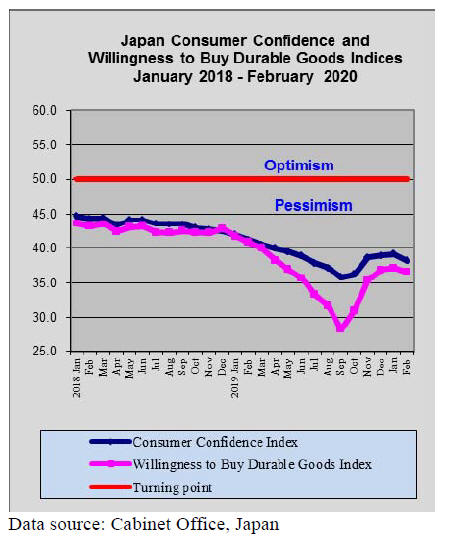
Surprising yen weakness in these times of
crisis
One possible outcome of the corona virus pandemic could
be a permanent change to the continual rush to the yen as a
¡®safe-haven¡¯ currency in times of crisis. In a game
changing moment towards month end the yen weakened
close to 10% against the dollar as fears spurred a rush to
the dollar.
Japanese policy makers have for the past decade
repeatedly tried to find ways to weaken the exchange rate
as a strong yen puts the export-reliant economy at risk.
The Japanese government, in concert with other major
countries, is preparing a massive stimulus to both cushion
and rebuild the economy when the pandemic is under
control.
This will require the government to issue more bonds pay
for the spending boost. However some analysts warn
against undoing the fiscal discipline in Japan that has kept
the economy afloat and further warn that the yen risks
crashing to lows never seen before.
There are already signs that investors are hoarding dollars
and there has been a huge outflow of cash from China. In
the worst case scenario it could be that Japan has to
intervene in the market to stem a decline in the yen against
the dollar as it did in the 1997 domestic banking crisis.
The Institute for International Finance has reported that
nearly US$42 billion has been shifted from emerging
economies since the beginning of the pandemic, the largest
outflow they have ever recorded.
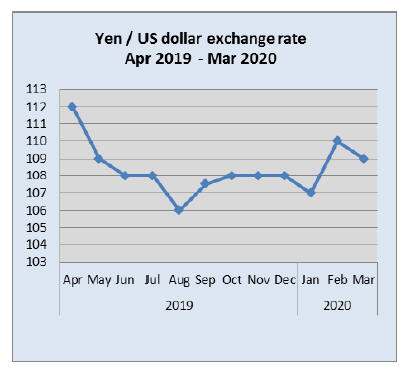
Tokyo Olympics postponed - athlete village
builders
stuck with huge apartment stock
One of the major issues for developers involved in the
construction of the athlete¡¯s Olympic village, built to
accommodate around 11,000 competitors, is how to now
renegotiate the deals done to sell the apartments now that
the games have been postponed.
The Olympic village is on a prime site in Tokyo and has
attracted private investment as the deal was to refurbish
and sell luxury apartments the selling prices of which are
close to US$1 million for many apartments.
Some 900 buyers are said to have already committed to a
purchase but real estate analysts have commented that
many prospective buyers may try and pull out of the deal
given the uncertainty surrounding the games.
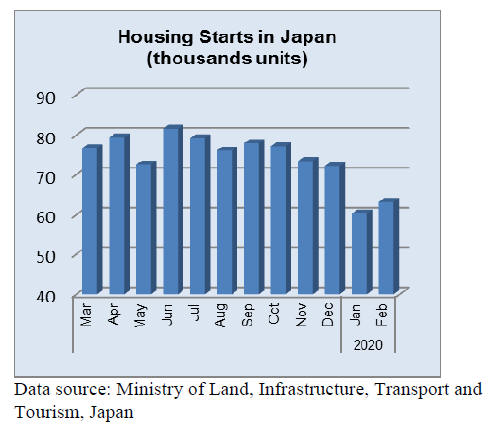
Import update
Wooden door imports
As in previous months four shippers accounted for over
90% of Japan¡¯s January 2020 imports of wooden doors
(HS441820). The main shipper was China with over 65%
of January arrivals followed by the Philippines (19%),
Indonesia (7%) and Malaysia (5%).
Year on year, January 2020 imports were down 9% but
compared to the value of imports in December there was
little change in January 2020.
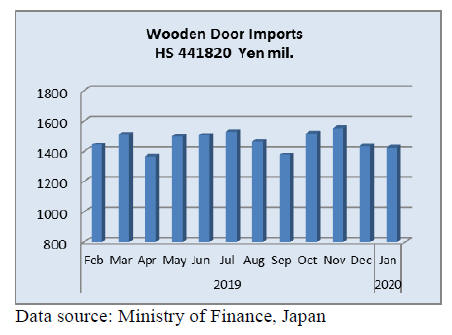
Wooden window imports
In the second half of 2019 the value of Japan¡¯s imports of
wooden windows (HS441810) were more volatile than in
the fist half of the year. Year on year, January 2020 import
values were down 17% but there was a 9% rise in the
value of January imports relative to a month earlier.
Just four shippers, China, US, the Philippines and Sweden
provided over 90% of the value of Japan¡¯s wooden
window imports in January 2020. Manufacturers in China
accounted for over 40% of January 2020 shipments of
wooden windows to Japan followed by the US (24%), the
Philippines (15%) and Sweden (11%).
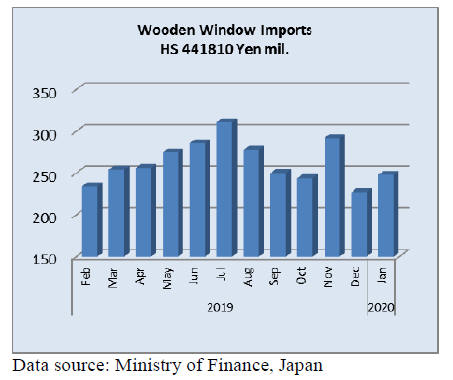
Assembled wooden flooring imports
Japan¡¯s imports of wooden assembled flooring rose
sharply in January 2020 compared to a month earlier but
year on year the value of imports was almost unchanged.
Of the four categories of flooring tracked HS441875 made
up around half of Japan¡¯s January imports followed by
HS441879 which added a further 23% to the total value of
assembled wooden flooring imports.
There were no imports of HS441871 in January and
imports of HS441874 made up just 3% of imports. China
and Indonesia were the main suppliers of HS441875 while
the US and Indonesia shipped most of HS441879.
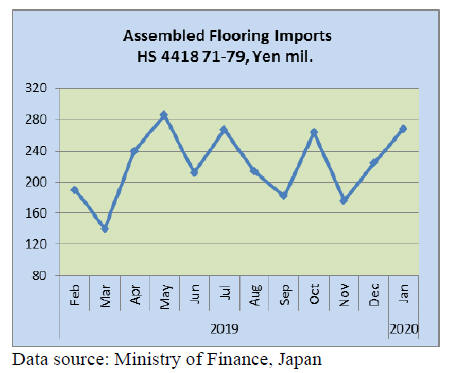
Plywood imports
Apart from the slight dip in the volume of plywood
imports in September 2019 there has been a steady
increase in the volume of imports since the beginning of
the second quarter 2019. However, the rise has not
benefitted all of the main shippers, Malaysia, Indonesia,
China and the new entrant into the market, Vietnam.
Monthly shipments from China have been around 10-
12,000 cu.m throughout 2019 but shipments from the top
suppliers, Malaysia and Indonesia have not been
consistent with the occasional marked decline in
shipments from one and then the other.
In January 2020 Indonesia was the largest supplier
accounting for 47% of Japan¡¯s plywood imports by
volume. Malaysia contributed a further 35% with around
18% being the combined shipments from China and
Vietnam.
Beginning in the second half of 2019 shipments from
Vietnam have exceeded those from China.
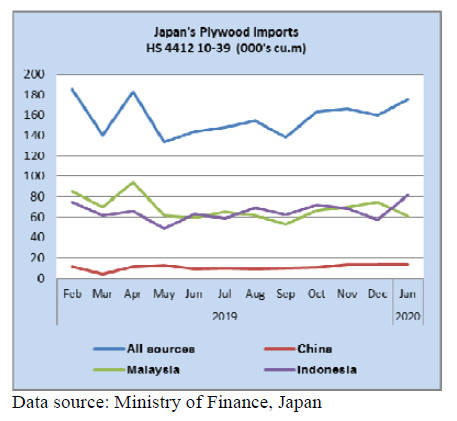
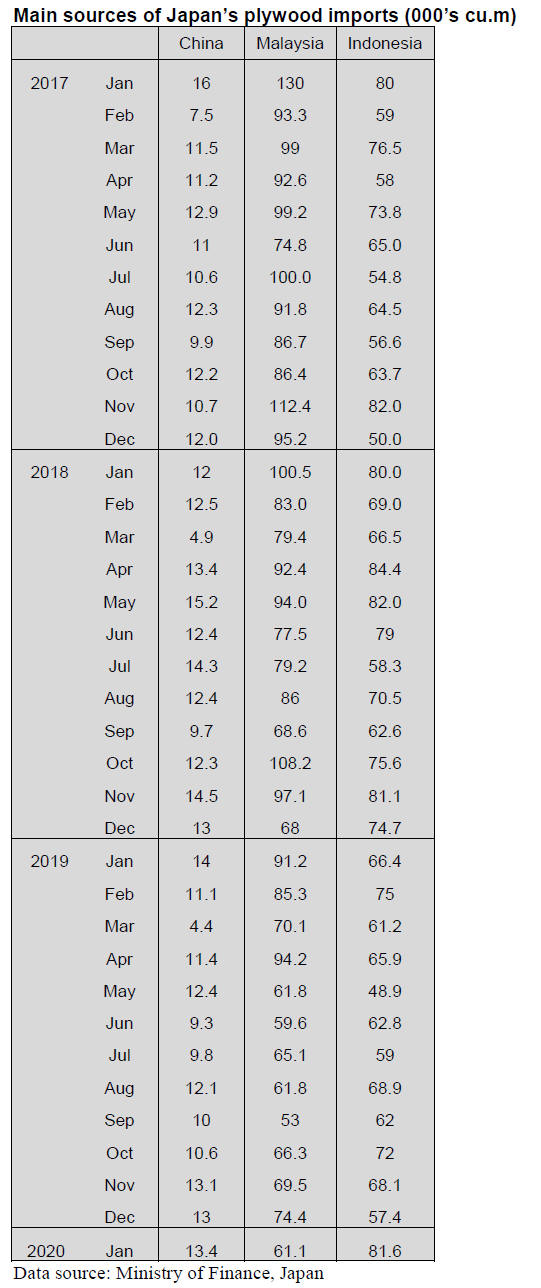
Trade news from the Japan Lumber Reports
(JLR)
The Japan Lumber Reports (JLR), a subscription trade
journal published every two weeks in English, is
generously allowing the ITTO Tropical Timber Market
Report to reproduce news on the Japanese market
precisely as it appears in the JLR.
For the JLR report please see:
http://www.n-mokuzai.com/modules/general/index.php?id=7
Corona virus disrupts supply chain
Japanese house builders are having shortage of housing
materials since many are supplied from China and the
supply is disrupted by wide spread of corona virus disease
in China. Since workers away from home have not
returned works by restriction of people¡¯s movement to
prevent from spreading virus after they visited old homes
during Chinese New Year¡¯s holidays in late January.
House builders in Japan are having problem to supply
contracted items. Houses may not be completed in time for
promised delivery period. Short items are parts of toilet,
IH heater for kitchen, built-in dish washer, wash basin and
air circulating fan.
Three or four major building materials companies
assemble kitchen, bath and wash basin but they are able to
assemble without parts. Delivery time is approaching so
builders are negotiating with house buyers if substituting
items are acceptable.
Without completion certificate issued by the official
organizations, house buyers are not able to receive subsidy
and housing loan without performance evaluation or
conformity agreement so the Ministry of Land,
Infrastructure.
Transport and Tourism instructed designated inspection
organizations and Housing Finance Agency to issue
completion certificate even if some of facilities are not
completed with house buyers¡¯ consent. Delay of deliveries
also influences cash flow of house builders.
Request for plant quarantine certificate
The Ministry of Agriculture, Forestry and Fisheries
reported infiltration of new breed of harmful insects has
been found one after another recently and it is urgent
matter to reduce or stop risk of such invasions. It requests
to attach plant quarantine certificate issued by country of
origin.
According to the plant quarantine law issued in 1950,
importing plants and containers have to have the
certificate issued by exporting country to prove that it has
no quarantine harmful insect or plant attached by the
inspection but actually for many years, import has been
allowed without such certificate if it is passed by the
Japanese quarantine inspection.
The request this time is to apply the rule on all the
importing plants even for the plants traditionally imported
without the certificate. Actually all the plants sent by mail
or brought in as hand baggage of travelers need to attach
the certificate.
The Ministry will analyze past examinations on items
traditionally imported without the certificate to see degree
of risk of having harmful insects and if the risk seems
high, the certificate is necessary.
As to imported wood products, KD lumber, laminated
lumber, plywood and wooden board are not object of
inspection but some logs, cants and custom cut lumber,
which have some bark left partly need to have the
certificate.
Imported debarked logs have low risk so they are likely to
be free of the certificate. For imported logs fumigated at
exporting countries, the certificate is necessary or
fumigation in Japan would be necessary.
Main log exporting countries like the U.S.A., Canada,
Russia, New Zealand and South East Asian countries have
experience to attach the certificate for China, which
strictly demands the certificate. When this request will
start is not known yet but it would be sometime this year.
North American lumber import in 2019
Total volume imported in 2019 is 1,757,142 cbms, 15.0%
less than 2018. Decline has been for six consecutive years.
Compared to recent peak of 2013, it is 38.7% less or more
than one million cbms drop in six years. Species of the
largest decline are hemlock and SPF.
By source, supply from the U.S.A. is 246,236 cbms, 0.8%
more than 2018. Canadian supply is 1,510,906 cbms,
17.1% less. Reasons of decrease from Canada is strike of
WFP since July 2019, which is the main supplier of
hemlock lumber and drop of SPF lumber market in the
North American market, to which the Japanese users
reduced purchase volume with prospect of further price
drop for coming months. This is why volume of hemlock
and SPF decreased from Canada.
On SPF lumber, North American lumber market soared to
record high prices of #2 & better in middle of 2018 then
the prices plunged by more than half and bearish mood
prevailed. At the same time, starts of rental units in Japan
have kept falling month after month, which is main market
for 2x4 lumber. Therefore, import of the first half of the
year was 27.7% less than 2018.
By drop of market prices, many sawmills either shutdown
the operation or closed for good so in the second half of
the year, supply reduction was feared so that the prices
bottomed out and the orders increased. Hemlock supply
was 155,431 cbms, 30.7% less than 2018 because of
lengthy strike of WFP.
At the same time, the demand in Japan declined because of
high export prices in 2018. The strike is over in February
after more than seven months. The supply of hemlock
resumes but future of hemlock market in Japan is
uncertain as users in Japan are tired of high export prices
and supply disruption by strike.
Douglas fir lumber was 374,498 cbms, 3.4% less than
2018. The supply from the U.S.A. remained unchanged
but Canadian supply decreased by WFP¡¯ strike.
Considering the fact that withdrawal of second largest
Douglas fir lumber manufacturer in Japan, Toa in late
2018 and disruption of hemlock lumber supply, there
should have been more demand for imported Douglas fir
lumber but there was no shortage in Japan market as
others like laminated lumber and domestic lumber filled
the gap.
Radiata pine logs and lumber imports in 2019
Import of New Zealand radiate pine logs was 354,502
cbms, 9.1% less than 2018. The market has steadily
shrinking year after year. Radiata pine log cutting mills are
also cutting domestic cedar logs and adjust production by
the crating lumber market and log cost.
China is now dominant radiate pine log user. China market
turned weak since March and April of 2019 by trade war
with U.S.A. and the export log prices weakened before
summer and the log prices for Japan dropped more than
$10 but after China market rebounded, the prices for Japan
also climbed together with climbing ocean freight.
Chilean radiate pine lumber import was 314,068 cbms,
5.8% less than 2018. Because of depressed demand of
crating lumber, there was no supply shortage.
In August, two ships arrived with short interval so that the
port inventories swelled up. Chilean lumber export prices
dropped since last fall but due to active other markets and
higher ocean freight, the Chilean lumber suppliers are
considering to increase the export prices.
In Japan, use of domestic cedar for crating lumber was
topic of the market in 2019. Cedar is more flexible in
pricing.
Russian logs and lumber imports in 2019
Russian log import in 2019 was 109,860 cbms, 11.8% less
than 2018. Declining speed is accelerating. Red pine logs
for lumber manufacturing increased but larch logs for
plywood manufacturing decreased. Log import outlook for
2020 is shadowy as log export duty rate increases and
harvest volume declines.
By species, whitewood logs increased by 9% but the
volume was only 5,600 cbms. Sawmills cutting whitewood
logs in Japan are limited and the main material shifted
from logs to genban so future looks unpromising.
Red pine logs increased by more than 50% as sawmills use
more logs since genban¡¯s supply and the quality are
unstable. Log export duty on larch logs from the Far East
Russia was 40% so the supply side was discouraged with
dropping profit.
Japanese plywood mills are using more Russian made
veneer and domestic species so plywood mills are losing
interest in Russian larch logs. The duty is raised to 60% in
2020 so larch log export would decline further. Supply of
high and medium grade red pine lumber was tight in 2019
but total volume was almost the same as 2018 due to
increase of lower grade lumber.
Plywood
Movement of plywood is getting stagnating on both
domestic and imports. Orders by precutting plants for
domestic softwood plywood is slowing and upward
momentum of imported plywood is disappearing and
dealers are warning of price drop in the market.
Operations of precutting plants are peaking out and
wholesale dealers now have ample inventories so no hurry
to purchase. Another negative factor is delay of construction
by wide spread of corona virus. Housing starts are
dropping and deliveries of contracted houses are largely
delayed by shortage of necessary parts from China.
March is book closing month and normally dealers try to
make more sales or to reduce on-hand inventory so that
the market is often confusing with spotty low offers.
Imported South Sea hardwood plywood market in Tokyo
is weak with slower movement. The importers are not able
to place future orders because of high export prices than
the market prices in Japan and at the same time, they need
to reduce the inventory and order balance. There was some
move to increase the market prices in the fourth quarter
last year but such vividness is now fading with weakening
demand. Particularly commodity items such as 12 mm
concrete forming are sluggish and there will not be any
recovery of the demand so severe market will continue.
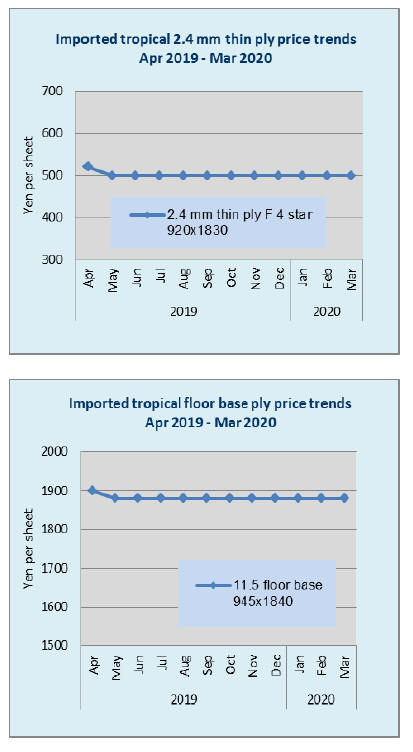 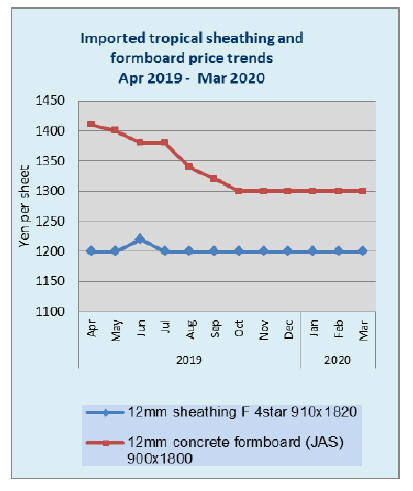
Domestic logs and lumber
Because of abnormal warm winter weather, log production
has been very active everywhere in Japan. Orders for
domestic lumber has been weakening since late February
so that sawmills slow down log purchase. Therefore, log
prices are weakening.
Sawmills prefer winter harvested logs as they can store
winter cut logs for several months so logs harvested are all
purchased by sawmills. 3 meter post cutting cedar log
prices are 11,100-12,500 yen, 500 yen lower than
February. 4 meter sill cutting cypress log prices are
17,000-18,000 yen, 1,000-2,000 yen down. If the lumber
demand stays stagnant, further drop of log prices is likely.
Larch and red pine log demand is active for both lumber
and plywood so the market prices are holding steady.
Particularly red pine log demand by plywood mills is
strong since Douglas fir log supply from North America
has been low so the demand for domestic species is
increasing.
Lumber demand continues slow. Reason is that orders for
new housing are slowing after corona virus epidemic and
such slowness may prolong. Lumber inventories are
increasing and the lumber market prices are softening. In
Tokyo market, 3 meter KD cedar 105 mm post prices are
about 49,000 yen and 120 mm post are about 44,000 yen.
Buyers are watching the market and cautious purchase
continues because of bearish future, which accelerate
slower trend.
Largest wood three stories school building
The largest wooden three stories grade school building
will be built at city of Nagareyama, Chiba prefecture.
This will have the largest floor space as grade school in
Japan. The construction will start in May 2020 and will be
completed in February 2021 so the school will be opened
in April 2021.
Nagareyama¡¯s population has been increasing and new
grade school is necessary to cope with growing number of
children. Main materials are locally produced cedar and
larch from its sister city in Nagano prefecture. The wood
volume used for the school is the largest as single school
building.
The new school has two buildings in North wing and two
buildings in South wing plus gymnasium. The first phase
is three school buildings with total floor space of 9,000
square meters, which are one hour quasi fire proof
structure plus 1,200 square meters of gymnasium. This is
the first wooden school buildings with floor space of over
10,000 square meters in Japan.
Total construction cost would be about 4.735 billion yen.
In Chiba prefecture, use of locally produced wood
products is a part of stipulations so LVL produced by
Keytec, which has manufacturing plant at Kisarazu, Chiba
prefecture can be used.
Post of both North and South wing school buildings and
beam of third floor are E60 cedar LVL and beams of first
and second floor are E120 larch LVL. Also E60 cedar
LVL is used for truss and beams of gymnasium. Total of
1,500 cbms of LVL is all produced by Keytec. For floor,
roof and ceiling panels, 750 cbms of spruce LVL supplied
by Metza Wood of Finland are used.
This will be the largest single unit of building with
structural LVL in Japan. Thickness of LVL for post and
beam is either 150 or 240 mm with width of 120-540 mm.
Truss thickness for gymnasium is all 120 mm with width
of either 180 or 240 mm.
|